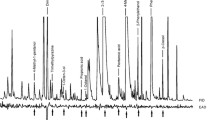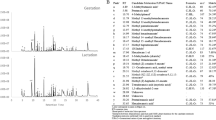Abstract
Cattle avoid grazing forage near their feces on pasture for more than a month. The relation of cattle feces odor to the rejection was studied in feeding choice tests using cattle. The feeding deterrent of feces odor was investigated using a trough partitioned to allow passage of feces odor through test food to the cattle. The cattle did not feed from the trough containing feces 0–35 days after excretion. Volatile chemicals isolated from feces 0–35 days after excretion by a cold trap method also inhibited cattle from feeding. These results demonstrated that feces odor is a major cause of the unpalatability of forage around cattle feces. The volatile chemicals were separated into ether and aqueous fractions. The ether fraction inhibited the feeding behavior of cattle. Furthermore, the ether fraction was separated into neutral, acidic, and basic fractions. The neutral fraction of the three was bioactive. These results suggested that specific volatile chemicals emitted from cattle feces were deterrents to the feeding behavior of cattle.
Similar content being viewed by others
References
Arnold, G.W. 1966a. The special senses in grazing animals. I. Sight and dietary habits in sheep.Aust. J. Agric. Res. 17:521–529.
Arnold, G.W. 1966b. The special senses in grazing animals. II. Smell, taste, and touch and dietary habits in sheep.Aust. J. Agric. Res. 17:531–542.
Arnold, G.W., andHill, J.L. 1972. Chemical factors affecting selection of food plants by ruminants, pp. 71–101,in J.B. Harbourne (ed.). Phytochemical Ecology. Academic Press, London.
Arnold, G.W., De Boer, E.S., andBoundy, C.A.P. 1980. The influence of odour and taste on the food preferences and food intake of sheep.Aust. J. Agric. Res. 31:571–587.
Castle, M.E., andMacDaid, E. 1972. The decomposition of cattle dung and its effect on pasture.J. Br. Grossl. Soc. 27:133–137.
Greenhalgh, J.F.D., andReid, G.W. 1968. The effects of grazing intensity on herbage consumption and animal production. HI. Dairy cows grazed at two intensities on clean or contaminated pasture.J. Agric. Sci. Camb. 71:223–228.
MacDiarmid, B.N., andWatkin, B.R. 1972. The cattle dung patch. 3. Distribution and rate of decay of dung patches and their influence on grazing behaviour.J. Br. Grossl. Soc. 27:48–54.
MacLusky, D.S. 1960. Some estimates of the areas of pasture fouled by the excreta of dairy cows.J. Br. Grossl. Soc. 15:181–188.
Marnane, N.J., Matthews, L.R., Kilgour, R., andHawke, M. 1982. Prevention of bark chewing of pine trees by cattle: The effectiveness of repellents.Proc. N.Z. Soc. Anim. Prod. 42:61–63.
Marten, G.C., andDonker, J.D. 1964a. Selective grazing induced by animal excreta. I. Evidence of occurrence and superficial remedy.J. Dairy Sci. 47:773–776.
Marten, G.C., andDonker, J.D. 1964b. Selective grazing induced by animal excreta. II. Investigation of a causal theory.J. Dairy Sci. 47:871–874.
Marten, G.C., andDonker, J.D. 1966. Animal excrement as a factor influencing acceptability of grazed forage, pp. 359–363,in Proceedings, 10th International Grassland Congress, Helsinki.
Norman, M.J.T., andGreen, J.O. 1958. The local influence of cattle dung and urine upon the yield and botanical composition of permanent pasture.J. Br. Grossl. Soc. 13:39–45.
Plice, M.J. 1951. Sugar versus the intuitive choice of foods by livestock.Agron. J. 43:341–343.
Tayler, J.C., andLarge, R.V. 1955. The comparative output of two seeds mixtures.J. Br. Grassl. Soc. 10:341–351.
Tayler, J.C., andRudman, J.E. 1966. The distribution of herbage at different heights in grazed and dung patch areas of a sward under two methods of grazing management.J. Agric. Sci. 66:29–39.
Voisin, A. 1959. Grass productivity. Trans. Herriot, C.T.M. Philosophical Library, New York.
Weeda, W.C. 1967. The effect of cattle dung patches on pasture growth, botanical composition, and pasture utilization.N.Z. J. Agric. Res. 10:150–159.
Weller, R.F., andPhipps, R.H. 1989. Preliminary studies on the effect of flavouring agents on the dry-matter intake of silage by lactating dairy cows.J. Agric. Sci. Camb. 112:67–71.
Author information
Authors and Affiliations
Rights and permissions
About this article
Cite this article
Dohi, H., Yamada, A. & Entsu, S. Cattle feeding deterrents emitted from cattle feces. J Chem Ecol 17, 1197–1203 (1991). https://doi.org/10.1007/BF01402943
Received:
Accepted:
Issue Date:
DOI: https://doi.org/10.1007/BF01402943




